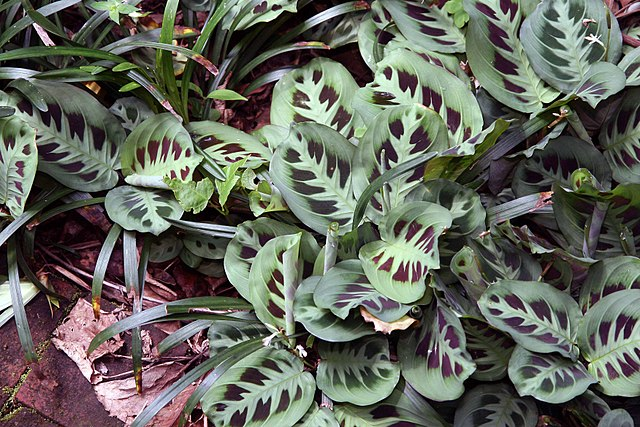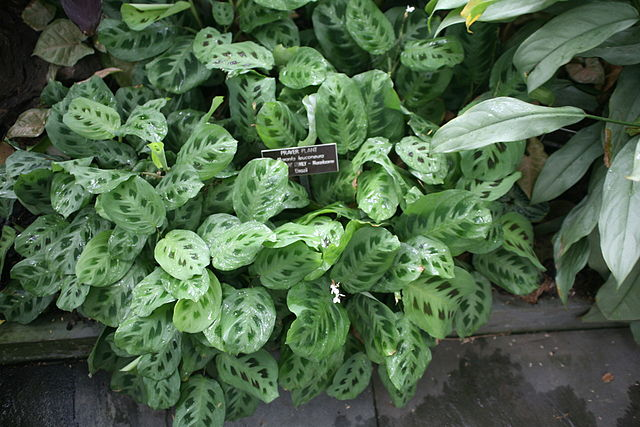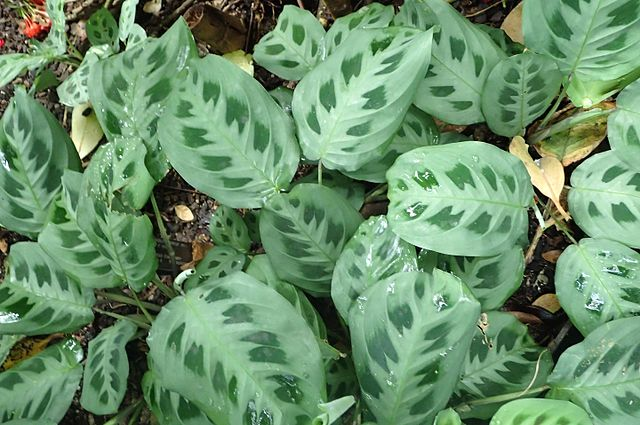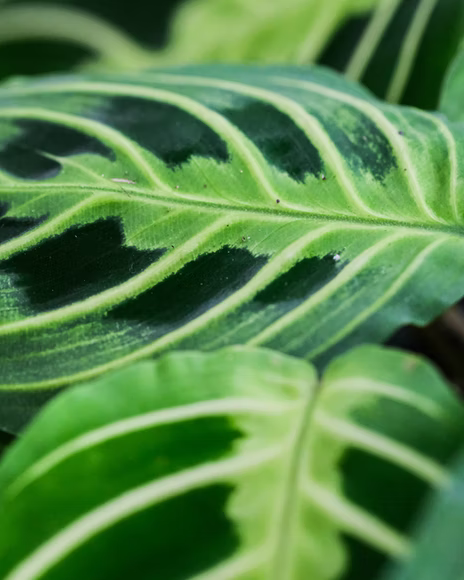Maranta, also known as prayer plants, are known for their ability to close and open their leaves. This variety, Lemon Lime, is a majestic, evergreen perennial with intricately patterned leaves. It is a very trendy prayer plant and is highly sought after by many plant enthusiasts due to its striking leaf pattern and venation.
Caring for this plant is a perfect leisure activity as it prefers to grow on its own at a slow and steady pace. Interested to know more? Keep reading!

Maranta Lemon Lime Profile
General Information
Maranta Lemon Lime is from the family Marantaceae that comprises Marantas, Stromanthe, Calathea, and Ctenanthe. They are all native to Asia, Africa, and South America. They grow about one foot in height and spread around 14 inches when it reaches maturity.
It is said that Marantas leaves close at dusk time and then reopen at dawn. This is one of their unique features that make them stand out and popular.
Etymology
The name Lemon Lime refers to its light green marking on the leaves that sets it apart from other Maranta. They are called prayer plants due to their beautiful leaves that look like praying hands. They are also called Herringbone Plant Lemon Lime and Prayer Plant Lemon Lime in some areas.
Flowering
This plant is not much known for its flowers, just like any other tropical houseplants, but it can produce delicate purple and white flowers. They grow atop their long slender stems and usually open and close within the day. Though short-lived, they are very charming and attractive.
Season Of Interest And Purchasing
This plant grows actively from spring through summer. Therefore, you may want to purchase this plant during those times and make sure you give your plant what it needs to thrive.
Growth
The Maranta Lemon Lime is slightly difficult to grow, unlike other house plants such as Pothos and Monsteras. They might also be a bit more picky about growing in some types of climates, but it will be easier once you get to know your plant’s preferences.
Maranta Lemon Lime Overview
| Scientific name | Maranta leuconeura var. Erythroneura ‘Lemon Lime’ |
| Common name/s | Lemon Lime Maranta |
| Family | Marantaceae |
| Growth Habit | Herbaceous |
| Height and Spread | Can grow up to 12 to 15 inches tall |
| Classification based on life cycle | Perennial |
| Origin and Distribution | Originates from Brazil |
| Climate Zone | Generally warmer climate |
| USDA Plant Hardiness Zone | USDA Zone 10 – 11 |
| Color | Dominantly green leaves with distinct pattern of venation, shading, and white veins, gray-green to purplish color in reverse side |
RELATED: Losing Faith in Your Prayer Plant? How to Save Your Curling Leaves
Care Tips

Light Requirement
The Maranta Lemon Lime plant grows best in sufficient bright, indirect lighting. Just make sure to protect this plant against harmful, direct light as this may cause leaf burns and even induce death to your plant. It is recommended that they are placed near shaded windows for optimal lighting.
Temperature Requirement
This plant loves to grow in areas that have consistent and warm temperatures. Ideally, they prefer 60 degrees to 80 degrees Fahrenheit. These plants are also relatively winter hardy, but anything below 60 degrees Fahrenheit can harm your plant’s leaves.
Water Requirement
The water requirement of Maranta is quite picky as it has low tolerance to the chemicals found in tap water or extreme water temperatures. Therefore, when watering your Lemon Lime plant, always make use of rainwater, distilled or filtered water, or room temperature bottled water.
In addition, this is also one of those thirsty plants that needs more water, so you should always keep its top soil slightly wet but never soggy. Always check the top 2-3 inches of the soil before watering. Permit the water to drain thoroughly also to avoid overwatering and eventually root rot.
During the winter, you can reduce the watering frequency as it becomes semi-dormant during this season.
Humidity Requirement
Marantas, just like any other tropical houseplant, enjoy high levels of humidity. If the moisture inside your home falls below 65%, it is recommended that you use a room humidifier to maintain its required air moisture. The use of pebble trays may also be helpful.
However, note that frequent misting is not advisable on this plant. Frequent misting may lead to the growth of fungal and/or infections caused by bacteria.
Soil Requirement
The Lemon Lime Prayer Plant has shallow roots, so they love to have an airy, light, and a potting mix that is peat-based. You can opt to use a good-quality ready-made potting mix or create your own mix. To do this, blend equal parts of coco coir, perlite, and peat moss to your potting soil.
If you wish to landscape your plant, you may use soil with organic compost, coarse sand, and fine gravel to create an airy, light, and well-draining mixture.
Fertilizer Requirement
Applying fertilizer to your Maranta is only recommended during the growing season. You can feed your plant every couple of weeks, preferably every two weeks, using any good quality, water-soluble plant fertilizer dissolved at half strength.
Please do not feed your plant during the fall and winter as it goes semi-dormant.
Space Requirement
The Maranta Lemon Lime has shallow roots, so it is recommended that they are potted in shallow plots instead of deep ones. This would avoid compaction of the soil, which may lead to mineral deposition and improper drainage. Choose also a pot that has 1-2 inches allowance growth, so you don’t have to repot it too frequently.
Growing and Planting Tips
Propagation
The preferred method for propagating Maranta Lemon Lime is through stem cuttings. Below are the easy steps to propagate your plant:
- Find a healthy stem and locate its node. The node is the intersection of the leaf with the stem.
- Cut the chosen stem just below the leaf node using clean, sterilized, sharp scissors or shears. Make sure that the node is intact because it is where new roots will form.
- Place the end of the cutting in water and rooting hormone (optional). The rooting hormone hastens the root growth.
- Plant the cutting in the desired mixture. You may see above soil requirements for reference.
- Cover your pot/container with a plastic bag. This will trap air and ensure high humidity for the cutting
- Make a few holes in the plastic to allow ventilation.
- Make sure that the cutting is placed in a location getting enough sunlight.
- When the roots reach 1 inch or are long enough, you can transfer them to a new pot.
Pruning
It is recommended that you trim away dead, yellowing, or damaged leaves, leaf tips, and stems as often as needed throughout the whole year. Pruning will help enhance the shape and fullness of your plant.
By the end of the winter, pruning may also be beneficial to induce your plant to grow out new and fresh leaves.
Potting And Repotting
It is best to repot your Maranta Lemon Lime annually, specifically during early spring. These plants are fast growers, so make sure to choose a pot that is one or two sizes bigger. If not possible, you can divide your plant into two and place them in the same size pot. Shallow pots are also recommended since they have a short root system.
Maranta Lemon Lime Care
| Light | Medium to indirect bright light |
| Temperature | Intermediate to warm, 60-80 degrees Fahrenheit |
| Water | Once a week, increased in summer, decreased in winter |
| Soil | Airy, light, well-draining mix |
| Fertilization | Regular household fertilizer, once a month |
| Space | Minimal space |
| Propagation | Via stem propagation |
| Blooming | Rarely blooms, enough sunlight and maturity needed |
| Pruning | Regular pruning |
| Potting | Regular potting mix, use of perlite, peat moss, coco coir and orchid bark is recommended |
RELATED: Alocasia wentii: The #1 Care, Watering, and Propagation Guide
Problems And Troubleshooting
Brown Or Curly Leaf Tips
Browning or curling of your plant’s leaves is an indicator of too much sunlight. Another possible reason is chlorine or other salts found in tap water.
To address this issue, use filtered water or any of the water mentioned in the water requirements above. You may also relocate your plant to a shadier place if suspecting that this is due to intense sunlight. Moreover, you should trip the brown or damaged leaves so that your plant grows lush green leaves.
Diseases
Any plant can be susceptible to diseases if not properly taken care of. Common diseases of the Maranta Lemon Lime include leaf spots and root rot. Leaf spots can be spotted if you notice water-soaked spots on the surface of your plant’s leaves. This disease can severely damage your plant’s foliage and may even kill it if not treated. On the other hand, root rot can usually be noticed through a foul odor.
These diseases are both results of overwatering, so make sure to get well-draining soil and only water your plant as necessary.
Pests
Mealybugs and spider mites are the most common enemies of the Maranta plant. Usually, they are more susceptible to these common pests when they are overwatered or underwatered. They feed on the plant tissues and sap, thereby depriving the plant of necessary nutrients leading to slowed growth.
Spider mites multiply quickly, so if you see the presence of webbings between stems and leaves, best to address them immediately.
To get rid of them, you can use neem oil, a natural pesticide. Mix 2 teaspoons of neem oil and one teaspoon of liquid dish soap with a quart/liter of lukewarm water. Place in a spray bottle and spray over the peperomia leaves.
You may also use 70-percent isopropyl alcohol and apply them directly to the bugs to kill the plant pests.
Maranta Lemon Lime Pests And Diseases
| Common Pests/Diseases | Symptoms | Treatment and Prevention |
Common diseases include crown rot, stem rot, root rot, leaf spot, fungal diseases, and Xanthomonas infection | Yellowish rimming around black or dark brown spots on leaves | Avoid overwatering. Keep soil dry. Avoid too high humidity.Proper ventilation is needed around the plant. Remove infected parts of fungal infections to avoid spreading. |
| Common pests include mealybugs, spider mites, aphids, and scales | Visible insects on the surface | Spray plant with warm, soapy water. If infestation is present, use insecticide or neem oil. Use diatomaceous earth. |
Problems With People And Animals
Toxicity
Marantas are not toxic to pets. Your cats and your dogs can happily roam and play around these plants.
Maranta Plants Meaning And Symbolism
Maranta or prayer plants symbolize the reflective action of a daily prayer of gratitude. These are perfect “thank you gifts” to your loved ones or any person you wish to tell you’re grateful of.
| General Meaning | Gratefulness |
| Symbolism | Daily prayer of gratitude |
Landscaping And Gardening Ideas

Companion Plants
Other tropical plants with bushy appearances or with a strike of color go well with the Prayer Plant. Some of the plants you may consider include bird of paradise, areca palms, fire spike, heliconia, variegated arboricola, croton, chenille plant, and pentas.
Some of these plants will have additional colors and hues of warm oranges and reds, perfectly complementing your greens.
Landscaping Ideas
Maranta plants can be hung or set near a window where they can receive ample, indirect sunlight. They are relatively small plants, so they are ideal for small spaces. If you are in a tropical or semi-tropical location you may also plant them directly into the landscape along a walkway or near the pool with other tropical plants.
A full plant can also be placed in the corner of the house or along the entryway. Outdoors, it can be a filler plant for a garden corner, in between palm trunks, or under tall trees. Marantas can also be used as a beautiful and premium ground cover.
| What to plant with | Bird of Paradise, Areca Palms, Fire Spike, Heliconia, Variegated Arboricola, Croton, Chenille Plant, Pentas |
| What NOT to plant with | Basically nothing |
Conclusion

The Maranta Lemon Lime is undoubtedly a standout among other houseplants; that’s why it’s really popular. Its attractive and unique foliage is worth getting and trying for any plant lover. Just make sure to give it what it needs, and it will happily open and close throughout the day for you!
Frequently Asked Questions
Is Lemon Lime Maranta rare?
Lemon Lime Maranta is a rare variety of the common houseplants Prayer Plants.
How often should I water my Lemon Lime Maranta?
To avoid overwatering or underwatering your Lemon Lime Maranta, check first the top 2 to 3 inches of soil before watering. If the soil still has moisture, skip watering first. However, if the soil is cracked and dry, water your plant.
On average, water the Lemon Lime 2-3 times a week during spring and summer, depending on your location. However, reduce the watering frequency during winter when the plant goes semi-dormant.
How do you propagate Lemon Lime Maranta?
Lemon Lime Maranta is propagated using stem cuttings. Just cut a healthy stem with two to three leaves and put them in a proper growing medium. Allow the roots to develop extensively.
Is a Maranta a Calathea?
No. Calatheas are different from Maranta plants, and vice versa. However, they come from the same family of plants, Marantaceae, hence the close resemblance.
How big do Maranta plants get?
With proper nourishment and care, Maranta plants can grow up to 10 to 12 feet tall.
Aside from maranta lemon lime, make sure to check out our other articles about foliage houseplants:
Alocasia Maharani: Helpful Plant Information and Care Guide For This Rare Beauty
Philodendron Pink Princess: The Perfect Care, Propagation, and Watering Guide
Monstera adansonii: The Complete Care, Propagation, and Watering Guide You Need







